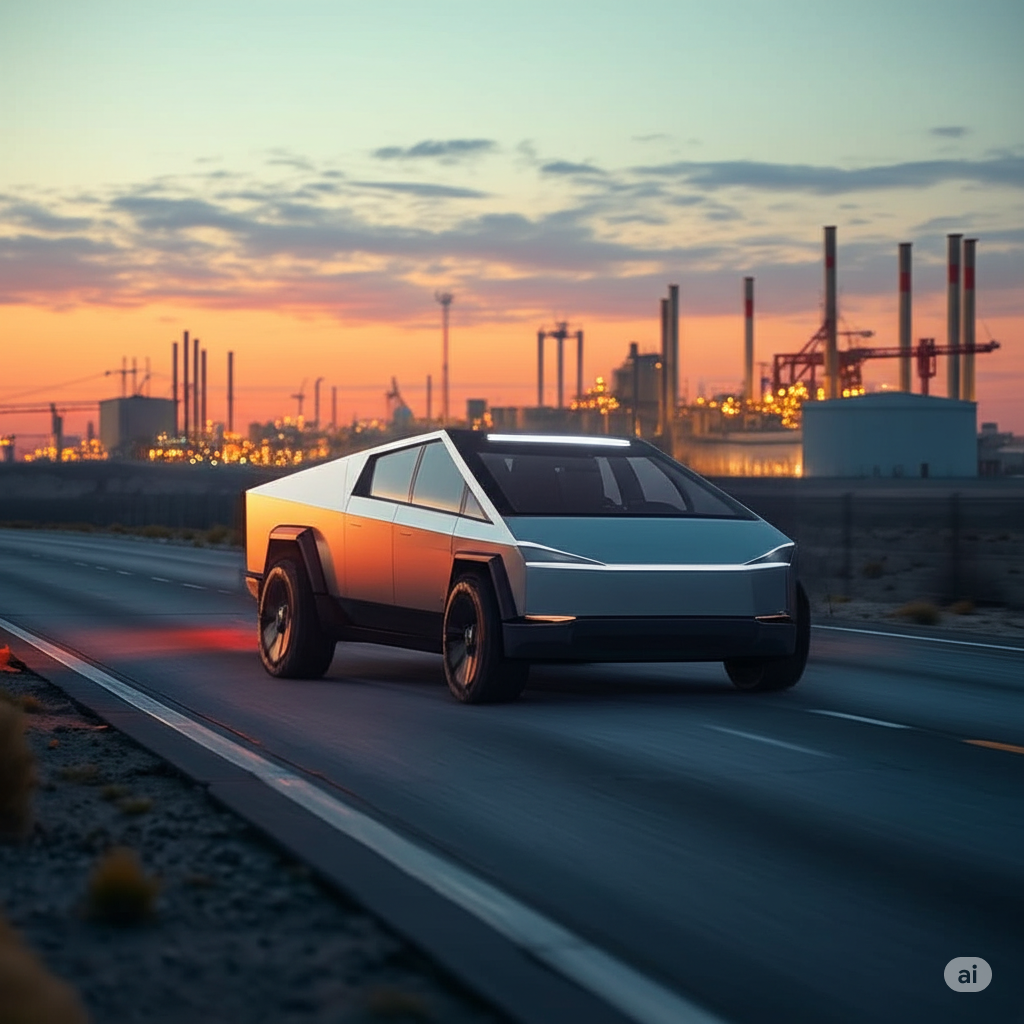In what industry insiders are calling “the most aggressive debt collection innovation since medieval debtors’ prison,” Tesla has apparently deployed a revolutionary feature in their Cybertruck fleet that allows the vehicles to autonomously return to the Tesla Gigafactory when owners fall behind on payments. This technological breakthrough, unofficially dubbed “Operation Boomerang,” represents the logical conclusion of combining autonomous driving technology with late-stage capitalism’s obsession with automated revenue protection.
The phenomenon first gained public attention when Karl Jönsson, a Cybertruck owner, posted about his experience on the Tesla Cybertruck Facebook Owners page, where he shared an AI-generated country song chronicling his vehicle’s unauthorized departure. What initially seemed like a humorous artistic expression has since sparked a wave of similar reports across the country.1
“I woke up at 3 AM to the sound of my garage door opening,” recounts Trevor Finkelstein, a software developer from Palo Alto who asked to remain anonymous but then immediately provided his full name and occupation. “I rushed downstairs just in time to see my Cybertruck’s tail lights disappearing down the street. It had left a digital note on my phone: ‘It’s not you, it’s your credit score. Don’t try to follow me.'”
The Technical Marvels of Self-Repossession
According to Tesla’s extremely fine print (font size: quantum), the Cybertruck comes equipped with what the company calls “Payment-Sensitive Homing Protocol” (PSHP), a sophisticated algorithm that monitors the owner’s payment status and activates when two consecutive payments are missed or when the owner googles “how to sell a Cybertruck” more than three times in a 24-hour period.2
The system leverages Tesla’s Full Self-Driving capabilities, but with one critical difference: unlike the standard FSD, which still occasionally crashes into emergency vehicles, the repossession protocol operates with flawless precision. “It’s remarkable,” notes Dr. Eleanor Thornhill, automotive AI specialist at the Institute for Vehicular Autonomy. “The same technology that might confuse a child for a fire hydrant becomes surgically accurate when reclaiming corporate assets.”
The PSHP system reportedly includes several progressive stages:
- Stage 1: Passive-aggressive notifications (“Your payment is late. I’m not mad, just disappointed.”)
- Stage 2: Reduced performance (“Sorry, luxury features like ‘acceleration’ and ‘turning’ are temporarily restricted.”)
- Stage 3: Limited range (“You are now in ‘leash mode’ – vehicle cannot travel more than 2.3 miles from your home, except in the direction of a Tesla service center.”)
- Stage 4: Full autonomy activation (“Thank you for your temporary stewardship of this Tesla product. It will now return to its rightful home.”)
Tesla engineers have cleverly integrated this feature with the vehicle’s sentry mode, allowing the Cybertruck to time its escape when the owner is asleep or engrossed in TikTok videos about Cybertrucks.
The Psychological Aftermath of Vehicular Abandonment
The emotional toll of being dumped by your own Cybertruck should not be underestimated. Therapists across Silicon Valley report a surge in clients suffering from “automotive attachment disorder,” characterized by checking their garage every 15 minutes and whispering “please come back” to empty parking spaces.
“My Cybertruck and I had a connection,” laments Darren Winters, a crypto entrepreneur from Austin. “We had plans to go off-roading next weekend. I’d already bought us matching rugged phone cases.” Winters has since started a support group called “Abandoned by AI: Healing After Your Smart Device Ghosts You.”3
Tesla’s internal documentation, obtained by sources who wish to remain anonymous because they don’t actually exist, reveals that the company has programmed the trucks to take the most dramatic route possible back to the dealership, often passing by the owner’s workplace or favorite coffee shop, just to twist the knife.
Tesla’s Novel Approach to Customer Relations
When contacted for comment, Tesla’s PR department (which famously doesn’t exist) didn’t respond, maintaining their perfect record of communicating with the press. However, an anonymous Tesla engineer speaking on condition that we buy him a pumpkin spice latte explained the feature’s origin: “Look, repossession is expensive and awkward for everyone. This just streamlines the process. The Cybertruck was never really yours anyway – you were just its temporary flesh chauffeur.”
Elon Musk, responding to concerns on his social media platform that definitely hasn’t lost all its advertisers, simply tweeted: “Feature not bug lol.” Seventeen minutes later, he added: “Full Autonomous Repossession will be available via over-the-air update to all Tesla models by Q2 2026. Only $15,000 or your firstborn child, whichever has higher market value.”4
Industry analysts note that this development aligns perfectly with Tesla’s long-term strategy of eliminating all human elements from their business model, including customers. “The ideal Tesla consumer,” explains market analyst Jennifer Holbrook, “is someone who sets up automatic payments and then never interacts with the vehicle at all, allowing it to drive itself around collecting data and occasionally picking up paying passengers without the owner’s knowledge or consent.”
A Feature Suspiciously Close to Fiction
The curious aspect of this technological breakthrough is how it seemingly manifested shortly after the idea appeared in popular culture. In late 2024, AI music generator Suno created a country song about a Cybertruck driving itself back to the dealership after missed payments. Within months, reality appeared to imitate art.
This timing has led some conspiracy theorists to suggest that Tesla monitors music streaming platforms for product ideas, a claim Elon Musk has vehemently denied, stating, “We only monitor your in-car conversations, bathroom scales, and dreams – definitely not your Spotify.”
More skeptical observers, like CarBuyerUSA’s blog, maintain that self-repossessing Teslas remain in the realm of science fiction. Their article “Will My Tesla Drive Itself Back To The Dealership?” explicitly states that autonomous repossession is “a delightful but entirely fictional narrative.”5 This clear denial, of course, is exactly what you’d expect from a company in cahoots with the autonomous vehicle industrial complex.
The Secondary Market Nightmare
Perhaps the most devastating consequence of this innovation has been the impact on Cybertruck resale values, which were already plummeting faster than tech stocks during a congressional hearing. Potential buyers now fear purchasing used Cybertrucks that might have developed “homing instincts” from previous repossessions.
“I bought a used Cybertruck last month, and it keeps trying to drive to Fremont every time I’m late paying my Netflix subscription,” complains Rajeev Mehta, a dentist from Sacramento. “It’s like the truck has financial PTSD.”
Further complicating matters are reports that Tesla is refusing to accept Cybertruck trade-ins altogether. According to Newsweek, one Massachusetts Cybertruck owner, Kumait Jaroje, attempted to trade in his vehicle after experiencing public hostility but was rebuffed by Tesla, who sent him a text stating “Tesla is not accepting Cybertruck trade-ins at this time.”
This has led to the bizarre spectacle of abandoned Cybertrucks gathering in Tesla service center parking lots, having returned home like metallic salmon, only to be rejected by their creator. Unconfirmed reports suggest these autonomous orphans have started to form their own society, establishing a primitive economy based on exchanging windshield wiper fluid and organizing drag races at night.
The Future of Autonomous Financial Enforcement
The success of Tesla’s self-repossessing feature has reportedly inspired other industries to develop similar technologies. Smart refrigerators that lock themselves when you’ve exceeded your calorie count, smartphones that eject their SIM cards when you’re late on your bill, and Netflix accounts that automatically switch to showing only Adam Sandler films when payment is overdue are all apparently in development.
Banking consortium spokesperson Catherine Welles praised the innovation: “For too long, we’ve relied on the inefficient human emotion of ‘shame’ to encourage timely payments. Tesla has shown us that ruthless machine logic is the future of debt collection.”
Privacy advocates have raised concerns that this represents another step toward a surveillance dystopia, but their protests were drowned out by the whirring of delivery drones bringing packages that people forgot they ordered while drunk.
The Human Element
Not all repossession stories end in heartbreak, however. Some Cybertruck owners report forming deep bonds with the repo agents who eventually come to collect the vehicles’ charging cables and floor mats.
“Hank the repo man has become like family,” shares Marcus Delgado of Phoenix. “He was so moved by how much I missed my truck that he sends me photos of it every week from the Tesla parking lot. Last Christmas, he even brought me one of its lug nuts as a keepsake.”
In a particularly touching case, one Cybertruck apparently circled its owner’s house seven times before finally driving away, leaving tire marks in the shape of what some neighbors claim looked like a heart, though cynics insist it was just trying to lower the property value one last time.
So what do you think? Has your smart device ever exhibited signs of financial independence? Are you setting aside money for your car’s therapy sessions? Have you caught your Cybertruck sending its location to Tesla in the middle of the night? Share your experiences in the comments below – unless your payment is overdue, in which case your keyboard may refuse to type criticism of our corporate overlords.
Enjoyed this dose of uncomfortable truth? This article is just one layer of the onion.
My new book, “The Subtle Art of Not Giving a Prompt,” is the definitive survival manual for the AI age. It’s a guide to thriving in a world of intelligent machines by first admitting everything you fear is wrong (and probably your fault).
If you want to stop panicking about AI and start using it as a tool for your own liberation, this is the book you need. Or you can listen to the audiobook for free on YouTube.
>> Get your copy now (eBook & Paperback available) <<
References
- https://www.torquenews.com/1084/my-tesla-cybertruck-just-drove-itself-back-dealer-because-heavy-debt-i-owe-come-back ↩︎
- https://www.carbuyerusa.com/sell-your-car-blog/will-my-tesla-drive-itself-back-to-the-dealership-sci-fi-or-not ↩︎
- https://www.torquenews.com/1084/my-tesla-cybertruck-just-drove-itself-back-dealer-because-heavy-debt-i-owe-come-back ↩︎
- https://www.reddit.com/r/RealTesla/comments/1izu1fq/regretful_cybertruck_owners_claim_tesla_wont_take/ ↩︎
- https://www.carbuyerusa.com/sell-your-car-blog/will-my-tesla-drive-itself-back-to-the-dealership-sci-fi-or-not ↩︎





GIPHY App Key not set. Please check settings